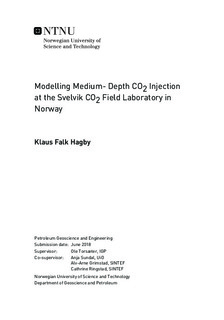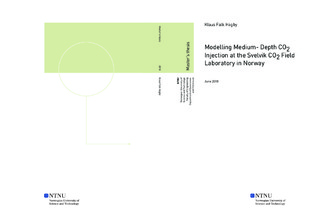| dc.description.abstract | The CO2 Field Lab is a test site at the Svelvik ridge near Oslo in Norway. It is presently being upgraded as part of the European research infrastructure initiative (the ECCSEL laboratories). The test site was established in 2010 by the SINTEF-coordinated "CO2FieldLab" project with the overall objective to study the performance of monitoring systems to detect and quantify CO2 migration and leakage.
Modelling of gas injection was performed in the previous projects as part of a feasibility study for geophysical monitoring. This modelling mainly considered the 10-m layer between 60 and 70 m, and consequently assumed zero permeability in the layers above and below. For the present work this constraint is relaxed by assigning a low but non-zero permeability also to the shallower layers.
The aim of the work in this thesis is to perform reservoir simulations to investigate major issues related to the operation of a field laboratory.
The previous gas injection modelling is simulated by using a homogeneous layercake model, with a simplified relative permeability. This model is evaluated, updated and discussed, in an attempt to increase the accuracy and resolution of the simulations. The geology of the Svelvik ridge is being reviewed, and it is assumed that there are anisotropy present in the north-south and vertical direction. The effect of this is tested by simulating a reduced permeability in the respective directions, for the relevant zones of the reservoir. The relative permeability is calculated by using Corey and Brooks equations, where relative permeability is a function of the grain size distribution. Imbibition curves were calculated with Carlson's method to investigate the effect of hysteresis.
The Svelvik field laboratory is intended for studies of the accuracy and sensitivity of monitoring methods for CO2 storage. An important part of a monitoring sensitivity test is extensive knowledge of the conditions prior to injection, both for fluid saturations, compositions (brine salinity and CO2 composition) and pressure. At the moment, before any injection has been performed, these conditions are well known. After the first experimental campaign has been completed, however, these conditions will be more uncertain. For the possibility of conducting more injection tests, it is important to know if and how quickly the conditions will approach a new well-known "reference" state. For pore pressure, this would be relatively fast, due to the relatively high permeability and the short distance to open water a few hundred meters to the north of the Svelvik ridge. For saturations, it would take much longer, and the end state depends on, among other factors, the transport of brine through the sediments. One of the topics that will be addressed in this thesis is whether it would be possible and/or practical to accelerate this process, by injecting brine for a prolonged period after the end of the gas injection test, or by producing the injected gas out of the reservoir. Due to a low fracture pressure, hence a low injection rate, the brine is not displacing the injected CO2 efficiently. Production from the reservoir can be a solution to accelerate the system to reach a "reference" state, where pressure and saturation are known. | |

